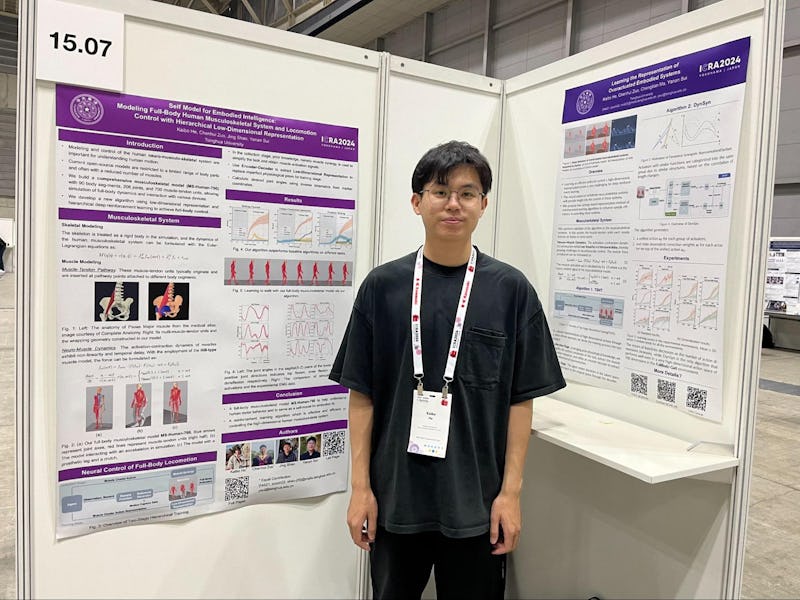Breaking Barriers in Robotics: Kaibo He’s Journey Of Innovation
Discover how Kaibo He is revolutionizing robotics by creating models that mimic human movement, paving the way for better rehabilitation and smarter robots.

Recent advancements in robotics have seen the development of machines that can closely replicate human intelligence and movement, unlocking their potential for analyzing data, performing physical tasks, and assisting in complex procedures with greater accuracy and precision.
It was this potential to solve real-world problems that first drew Research Scientist Kaibo He to robotics. He’s now pushing the limits of the technology in pursuit of new and improved ways to develop robots capable of seamlessly interacting with their environment.
Read on to explore Kaibo He’s career and how his work is enabling the development of more advanced robotic systems.
Kaibo He: Discovering A Passion For Robotics
Kaibo’s interest in robotics began during his undergraduate studies, when he pursued a bachelor’s degree in engineering. Like many students, he explored different disciplines, including math, programming, and entrepreneurship, in search of a field that engaged him on a deeper level.
He eventually entered a robotics competition and became fascinated by creating machines capable of performing manual tasks with human-like precision. Whether automating repetitive tasks, exploring hazardous environments, or assisting with delicate medical procedures, robotics offered a tangible way to apply algorithms and engineering principles to solve real-world challenges and help professionals tackle complex problems with greater accuracy.
Keen to delve deeper into the field, Kaibo pursued a master’s degree in machine learning and robotics, during which time he received several academic awards and scholarships.
This foundation in both theory and practice provided Kaibo with the technical foundation to tackle some of the most challenging problems in robotics.
His Work With Musculoskeletal Modeling
Kaibo’s first major robotics project involved a research initiative aimed at improving rehabilitation techniques for spinal cord injury patients using brain-computer interfaces (BCIs) — systems that create a direct link between brain activity and external devices.
While BCIs can detect and stimulate brain signals, Kaibo and his team found they struggled to translate those signals into the coordinated muscle movements needed for tasks like walking, limiting their effectiveness in helping patients regain mobility.
Kaibo proposed creating a musculoskeletal model (a computer-based simulation of the human body’s muscular and skeletal systems) to better understand how human movement is generated and controlled. By working with realistic simulations of how forces travel through the body during motion, these models could provide deeper insights into how the body adapts to severe movement loss, which would allow researchers to develop more effective rehabilitation treatments.
However, Kaibo quickly encountered a major obstacle: most existing models couldn’t accurately capture the complexities of human movement.
This is because traditional models rely on motors placed at the joints to generate movement, producing direct and predictable responses. In contrast, the human body moves through muscle-tendon units that pull on bones, often with multiple muscles controlling a single movement, forming a complex interplay that makes natural human motion difficult to predict and recreate in a computational model.
To tackle this challenge, Kaibo developed an algorithm that could accurately capture these complex biomechanical interactions within the musculoskeletal model by using Reinforcement Learning, a Machine Learning approach that improves systems through trial and error. He trained this algorithm by feeding it motion capture data from actual human movements, which allowed the system to evaluate its performance against accurate footage of motion patterns, slowly adjust its parameters based on feedback and testing, and gradually refine its ability to control muscle contractions and coordination with greater precision.
This breakthrough resulted in a more accurate and realistic musculoskeletal model, providing researchers with a valuable tool to study movement patterns and develop rehabilitation treatments for spinal cord injury patients. Kaibo’s contributions were later recognized by the International Conference on Robotics and Automation (ICRA), one of the field’s leading research conferences, highlighting the huge impact of his project.
Kaibo’s initiative improved musculoskeletal modeling and provided a more effective way to study movement impairments, helping to create systems that can better support individuals with physical disabilities.
Kaibo’s Vision for the Future Of Robotics
After completing his master’s degree, Kaibo joined Clone Robotics, a company dedicated to developing musculoskeletal androids, as a research scientist. At Clone, he continues to build on the foundation laid during his academic work, with the goal of assisting these models in tackling real-world challenges and improving how they interact with their physical surroundings.
Kaibo sees the rapid advancements in AI as a key element of this. While robots still struggle to replicate human-like physical interactions, he believes they can benefit from the significant improvements AI has made in refining digital cognitive capabilities, as seen in Large Language Models.
His long-term aim is to merge these cognitive functions with advanced motion control and reinforcement learning techniques to develop general-purpose humanoid robots that can not only imitate human movements accurately, but also learn and adapt through experience and refine their abilities over time.
By integrating these technologies, Kaibo believes robots will be able to bridge the gap between thought and action, enabling them to collaborate effectively with humans in real-world environments.
Shaping the Next Generation Of Robotics
Kaibo’s work is helping to improve the way robots can predict and simulate human movement. By training biomechanical models with advanced learning techniques, he’s helping to develop more precise rehabilitation methods for spinal cord injury patients and improving the accuracy and adaptability of robotic systems in understanding human motion.
As this field continues to evolve, Kaibo He is helping robots become more effective tools for professionals by making them capable of assisting in both scientific research and everyday tasks.
If you want to learn more about Kaibo He’s academic work and professional accomplishments, visit his personal website.
BDG Media newsroom and editorial staff were not involved in the creation of this content.